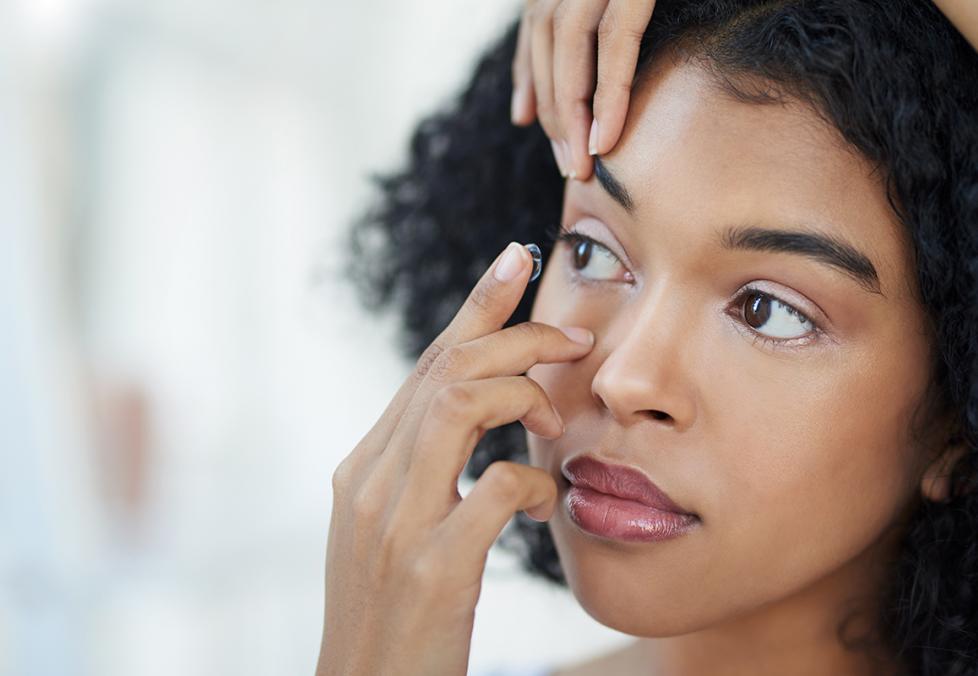
Today, what's good for your eyes is also good for the planet. Discover the frames, contacts, and practices that are lowering our environmental impact.
Everything you need to know to take care of your eyes — for life.

Deciding to wear contact lenses is the first step. Next, you have to choose which type to wear. Dailies are a popular option, as they offer many perks.
Because you wear a new pair every day, daily contact lenses are convenient, easy to use, and carry a lower risk of eye infections. Plus, they tend to be more comfortable than monthly contact lenses. It doesn’t get much better than that.
However, dailies have a few downsides: They’re pricier, less environmentally friendly, and don’t offer as many options for more complicated prescriptions.
Wondering if daily contacts are a good option for you? Here, Jeff Foster, O.D., an optometrist at America’s Best Contacts & Eyeglasses in San Antonio, Texas, explains what you need to know.
Did you know that contact lens prescriptions need to be renewed every year? Find an exam time that fits your schedule!
Like other contact lenses, dailies are clear, thin disks you wear in your eyes to correct vision problems such as nearsightedness and farsightedness. They’re typically made of soft, water-based plastic materials known as hydrogel and silicone hydrogel material.
Some contact lenses, such as monthly contact lenses (or monthlies), can be cleaned and reused multiple times. But dailies are meant to be inserted in the morning and thrown away at the end of the day.
Daily contact lenses, like all contacts, are considered prescription medical devices. That means you’ll need a prescription from an eye doctor to get them.
Because dailies only need to last one day, they’re thinner and less durable than monthlies.
For that reason, dailies tend to feel more comfortable. “When we ask somebody, ‘When are your contact lenses the most comfortable?” they will generally say, ‘When I open up a new pack,’” says Dr. Foster. With dailies, you get to wear a fresh pair every morning.
Opening a new pack each day also means you don’t need to worry about cleaning your lenses. Monthlies, on the other hand, require regular cleaning and storage. So, dailies score another point for convenience.
Dailies are less environmentally friendly than monthlies. (You’re tossing out as many as 730 little bits of plastic a year.) But that’s changing. For example, Sofmed® Breathables™ 1-Day contact lenses from America’s Best are now plastic-neutral.
Daily lenses are also typically more expensive than monthly lenses. And prices can run higher if you need a specialized prescription, such as one for astigmatism. If you’re using vision insurance benefits, check with your optometrist and insurance plan before settling on dailies. The America’s Best Eyecare Club can also help keep the cost of dailies within your budget.

Today, what's good for your eyes is also good for the planet. Discover the frames, contacts, and practices that are lowering our environmental impact.
Compared to wearing eyeglasses, wearing contact lenses puts you at a greater risk of an eye infection because you have to touch your eye every time you put them in, Dr. Foster says.
However, most eye doctors agree that dailies are healthier for your eyes than monthlies. “The prevalence of eye infections with daily contact lenses is significantly lower,” Dr. Foster says.
Monthly contact lenses build up deposits over time that even nightly cleanings can’t get rid of. The longer you wear the lenses, the greater the chances of those deposits making their way into your eyes and causing a serious infection, such as keratitis.
While dailies don’t eliminate your infection risk, they do ensure perfectly sterile contacts every time you open a new blister pack. Therefore, they tend to be healthier for your eyes than reusable contacts.
Dailies are available in a few different soft contact lens types. These include:
Daily contact lenses are a great option for people who don’t want the hassle of cleaning and storing their contact lenses every night.
“People who travel a lot and don’t want to have to carry solution and a case are a great candidate for a daily contact lens,” Dr. Foster says. All you have to do is throw a few blister packs in your travel bag and you’re all set.
Kids are also well suited to daily lenses, as nightly cleanings can be tough to stay on top of.
Dr. Foster says dailies can be great for people with allergies and sensitive eyes. Even with regular cleanings, monthly contact lenses can hold onto tiny allergen particles, such as pollen. Monthlies also tend to lose moisture over their 30 days. That, plus repeated cleanings with the chemicals in contact lens solution, can irritate eyes. Dailies tend to be gentler and, therefore, a better option for people with allergies. And because they’re tossed out at the end of every day, there won’t be a pollen buildup on the lenses.
However, Dr. Foster notes that there isn’t a daily multifocal toric — yet. There are fewer types of daily contact lenses. This may put them out of reach for people with more complicated prescriptions. Dailies may be more ideal for people with mild to moderate vision issues.
One of the great things about daily contact lenses is that it doesn’t take much effort to care for them. Simply wear them and toss them the end of the day.
That said, all contact lenses carry a risk of infection. Minor infections can cause pain and interfere with your daily routine. Meanwhile, serious infections affect up to 1 in 500 contact lens wearers per year. So, proper contact lens hygiene is essential, even when using a fresh pair every day.
Always wash your hands before putting in your lenses or taking them out. Otherwise, you risk transferring infection-causing germs from your hands into your eyes or onto your contact lenses. Use soap and warm water, then dry your hands with a clean towel before handling your lenses.
To learn more about daily contact lenses, make an appointment for a contact lens exam. During the exam, your eye doctor will check your vision, fit you for a prescription, and measure each of your eyes to determine the proper lens fit.
In addition, your eye doctor will ask you about your daily habits and routine. Your lifestyle plays a key role in determining which contact lens option is best for you, so be honest in your answers.
Medically reviewed by Jeff Foster, O.D.
See our sources:
Soft contact lens materials: Optometrists Network
Healthy vision and contact lenses: American Optometric Association
Contact lens fast facts: Centers for Disease Control and Prevention